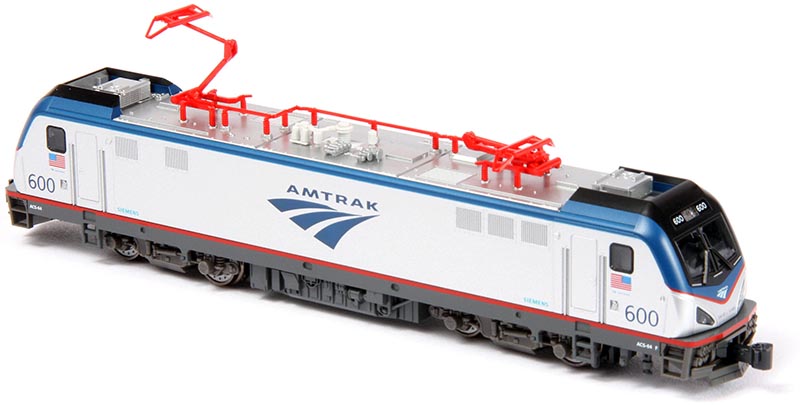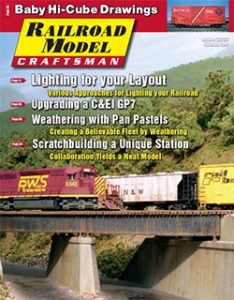 By David Otte
By David Otte
On February 7, 2014, the new face of motive power on Amtrak’s Northeast Corridor (NEC) showed itself for the first time in revenue service — the ACS-64 Cities Sprinter. The 70 double-ended electrics ordered to date were built in the U.S. by German conglomerate Siemens AG at an estimated cost of $466 million and designed specifically to pull regional trains along the Boston-New York-Washington, D.C. route at speeds of 125 m.p.h., as well as haul passenger consists on the Keystone Corridor between Philadelphia and Harrisburg, Pa., at 110 miles per hour.
Now, Kato is offering an N-scale rendering of this modern Amtrak racehorse for the contemporary modeler’s motive power roster. Available in three different road numbers, the DCC-ready locomotive carries a suggested retail price of $150.
As Amtrak came to the end of its first decade in the 21st Century, the writing was clearly on the wall that the aging electric locomotive fleet, consisting of Electro-Motive Division AEM-7s, some approaching the 32-year service mark, and newer, but troublesome, Bombardier–Alstom HHP-8s, were in need of dire replacement. After the passage of the Passenger Rail Investment & Improvement Act (PRIIA) of 2008, Amtrak was not only reauthorized, but given the task of revamping the intercity passenger railroad system in the U.S. As part of its subsequent Fleet Strategy program for “building a sustainable fleet for the future of America’s intercity and high-speed passenger railroad,” Amtrak submitted a plan to purchase over the next decade 825 new single-level cars, 22 trainsets for high-speed trains, 508 bi-level cars, 280 diesel locomotives, 42 switchers, and 70 new electrics.
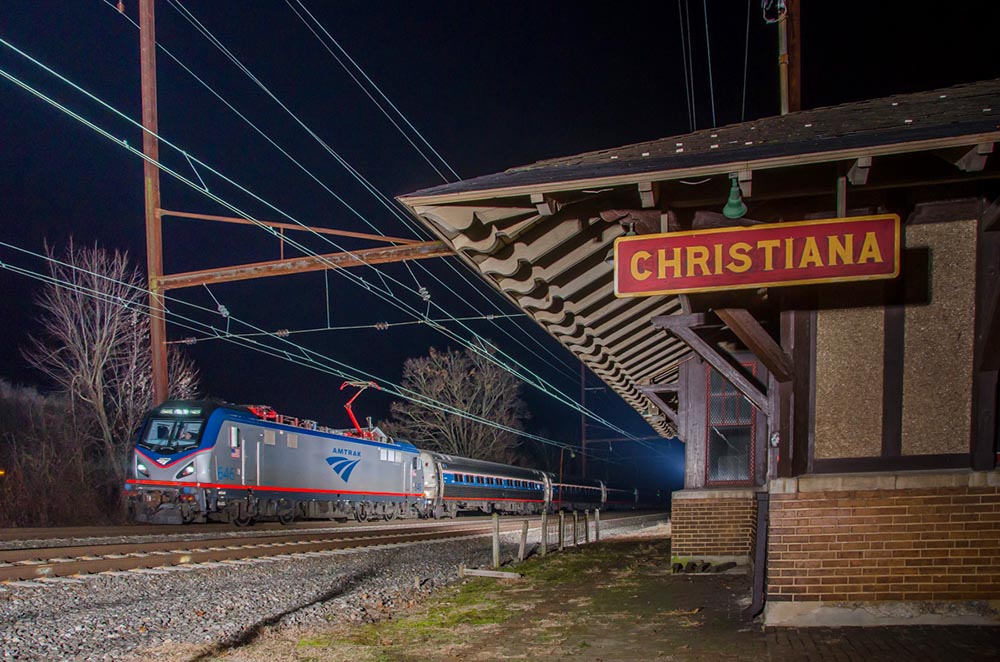
An Amtrak Keystone Corridor train passes the privately owned ex-Pennsylvania Railroad station at Christiana, Pa. The train is heading for Lancaster and Harrisburg with ACS-64 No. 646 in the lead on December 11, 2015. Steve Barry photo
Siemens, who had great success with its EuroSprinter and Vectron electric locomotives, as used in Europe and Asia, seemed like a likely candidate for building the new Amtrak electric locomotives. The company’s Rail Systems Division commenced designing a locomotive based on its monocoque structured body electric platforms that would meet Amtrak’s stringent guidelines. In particular, FRA safety requirements would have to be met, including crash energy management components like crumple zones that would protect the engineer in the cab in case of collision, plus full-width anti-climbers and push back couplers that help keep the wheels of the consist on the rails. The resulting structural enhancements pushed the weight of the locomotive over 215,000 pounds, some 20,000 pounds more than the heaviest European designs, but the locomotive was still required to meet Amtrak’s other minimum obligation too — the ability to haul 18 Amfleet coaches at 125 miles per hour while at the same time providing 1,000 kilowatts of Head-end Power (HEP) for powering the consist’s environmental systems. Above all else, it needed to be built in the U.S. with 51 percent of the components from U.S. suppliers, per the PRIIA’s “Buy American” standards.
Siemens unveiled its first three Cities Sprinters, 600–602, in May 2013 and presented them for testing at the Department of Transportation’s Technology Center in Pueblo, Colorado, and on the NEC that summer. The test data was impressive. The 66-foot, 8-inch long (over the coupler pulling faces) locomotives, designated ACS-64 by Amtrak, could attain a maximum speed of 135 miles per hour, had a starting tractive effort of 72,000 pounds, and took a 18- car consist from 0 to 125 miles per hour in less than eight minutes and half that size train to the maximum service speed in 2.5 minutes. The new electrics can operate on either 25,000/12,500 volts at 60 Hertz or 12,000 volts at 25 Hertz overhead systems with an impressive peak power output of 6,400 kilowatts (8,700 horsepower) and continuous output of 5,000 kilowatts (6,700 horsepower). The ACS-64 is not equipped with dynamic brakes but instead relies on regenerative braking that can feed up to 100 percent of train brake energy back into the catenary system (when the grid can accept that much power), which can amount to as much as a 15 percent energy savings per year.
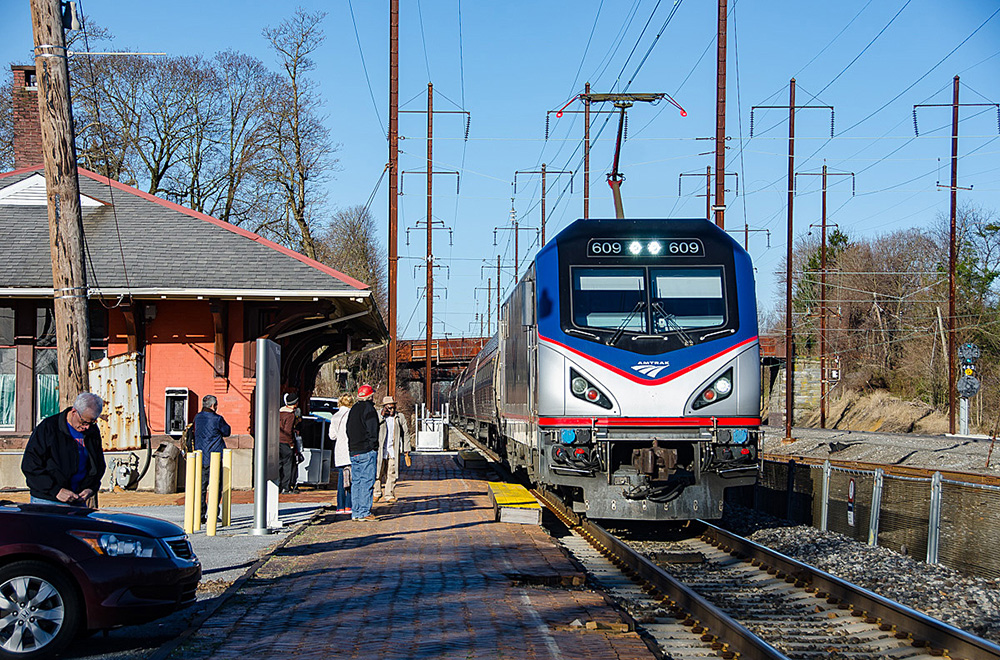
A Philadelphia-bound Amtrak Keystone Corridor train eases to a stop in Parkesburg, Pa., on its way from Harrisburg on April 8, 2017. Steve Barry photo
Furthermore, the electric locomotive features two converters each feeding three water-cooled inverters per truck. Two of the inverters are then connected to the two Alternating Current (AC) traction motors in their associated truck with the third unit serving as the HEP inverter, which, between the two trucks’ independent electrical circuits, offers a redundant power supply for the passenger consist (only one HEP inverter is online at any given time). Cab controls and accommodations are state-of-the-art as well and all integrated with the traction and locomotive control management system known as Sibas 32. The on-board computer system, which allows for self-diagnosis of technical issues, can notify the engineer of a maintenance issue and then take self-corrective measures, such as switching to a back-up or redundant system, decreasing speed, and adjusting performance levels, to maintain operation of the locomotive and ensure its safety. The microprocessor system, along with the ACS-64’s built-in cost effective maintenance design, ensures that locomotives see as little down time as possible.
Pleased with initial testing, Amtrak gave Siemens the green light to begin full production, and new Cities Sprinters have been rolling off the company’s solar powered Sacramento, California, rail manufacturing plant ever since. Parts for the ACS-64 are also being provided by Siemens’ plants in Ohio and Georgia, plus some 60 other suppliers in more than 50 cities and 20 states — well exceeding the Buy American standards. The last unit, number 670, rolled off the assembly line in June 2016 and entered service in August, closing out the original order.
Railfans are currently enjoying the sights of these classy speedsters daily on the head end of Northeast Regionals, but also have seen them, on occasion, leading the Miami-bound Silver Meteor, or even double-heading a 60-car Ringling Bros. and Barnum & Bailey circus train to New York. Meanwhile, the fleet of tired-out AEM-7s and maintenance-heavy HHP-8s have finally all been retired with some units being placed in storage while others are already being scrapped.
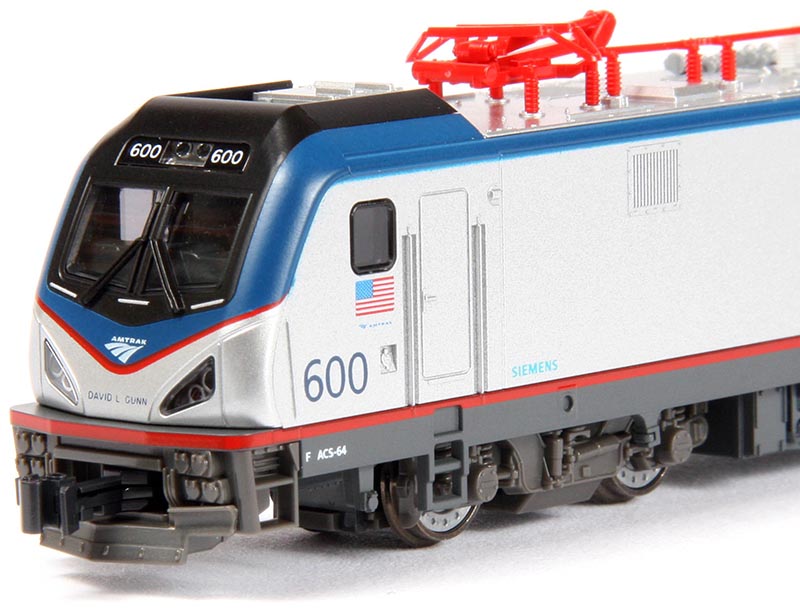
Crafted in Japan, Kato’s N-scale ACS-64 certainly captures the modern, streamlined appearance of the European- designed Sprinter. At 4.9375-inches long over the pilots, the model follows the general carbody proportions of the prototype closely, including its 9-foot, 10-inch width and 12-foot, 6-inch height (excluding pantographs). The only discrepancies found when compared to published dimensions were the distance between truck centers being about 10 scale inches shorter (1/32 of an inch in either direction) than that of the real deal’s 32-feet, 6-inches and the drivers measuring out to be 46 scale inches rather than the appropriate 44 inches. Not really noticeable to the naked eye, these minor deviations from the prototype are more than likely due to operational considerations within typical N gauge track scenarios.
Constructed from an injection-molded carbody, separate sill cover with integral underbody components, and a full die-cast metal frame, the bulk of the details are molded in, but done so to Kato’s usual exacting degree. Highlights include car side and rooftop air intake grilles, the plethora of visible bolt heads fastening down the three major roof panels, and roof conduit leading to the air conditioning units and air horn locations along with junction boxes and other various associated electrical connections (most of which are hidden from ground level view by an aerodynamic shroud atop each cab roof). Additional features include handholds alongside the cab access doors, which are complete with handles; ladder- style frame steps; windshield wipers; assorted underside hardware; and rooftop antenna — all crisp in execution.
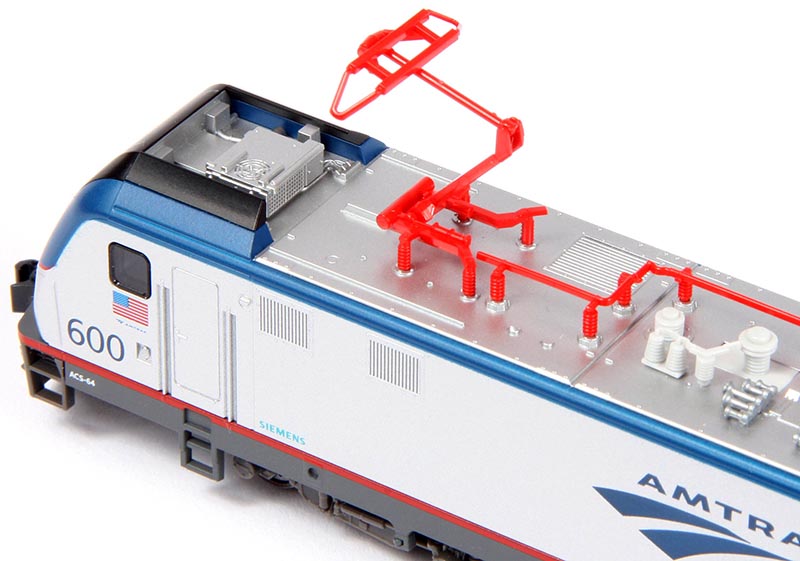
That’s not to say the N-scale rendering is without some separately applied parts too. Perhaps the most obvious are the red pantographs on the roof. Each assembly is made up of four individual pieces and is articulated so that they can be positioned up or down. Being made of plastic. However, they are a bit fragile, and care will need to be taken to ensure they survive a trip under the wire. Situated between the juice jacks on the roof are a red-colored electrical conduit with insulators, gray-colored insulators, and two sets of silver five-chime air horns.
Furthermore, air conditioning units have been installed on the cab roofs; there is window glazing in the cab windows along with simple interior inserts; headlight and number board lenses are in place; and the pilots with their shallow plows, stirrup steps, and Kato plastic operating couplers have been snapped onto the ends of the frame. Finally, all packaged together, the 1:160 Cities Sprinter rides atop plastic renderings of Siemens’ model SF4 two-axle trucks complete with molded-in coil spring and strut details and outfitted with blackened metal drivers, each featuring gray plastic inserts that display the prototype’s wheel face pattern — a very nice touch.

Kato’s current ACS-64 offerings include numbers 600, 627, and 648. RMC received No. 600 for review, which is of special significance among Amtrak’s fleet to date as it carries the name “David L. Gunn” on its lower car ends in honor of the former Amtrak president, who has done much for the passenger rail transportation system in both the U.S. and Canada throughout his long career in the industry.
Amtrak’s latest paint scheme is quite eye-catching, as one can tell from Kato’s well-executed replication of it on the Nscale model. While mostly a silver carbody with black cab face and shroud, the roof is highlighted by a blue outline with the color then flowing down along either side of the cab windshields and terminating as a shallow chevron on the ends. This scheme is further enhanced by a gray-painted sill and pilot picked out with red pinstriping. There are plenty of miniature graphics to enjoy as well. These begin with the modern Amtrak logo, known as Travelscape; the tiny “SIEMENS” on all four lower corners of the side panels; the U.S. flag properly oriented beneath the cab side windows along with an even smaller Amtrak logo; the locomotive class designation printed on both ends of the side sills with the appropriate end marked “F” for front; and, finally, the Amtrak logos on the car ends with the sharply reproduced road numbers on the carbody cab sides and in the number boards all standouts as well.
Beneath the attractive appearance of the smooth-sided carbody is a precision drive mechanism too that delivered excellent results during my testing. Utilizing a Digital Command Control (DCC)-friendly split-frame design, the N-scale ASC-64 is equipped with a coreless motor outfitted with dual flywheels, which drive all axles via plastic gearing. In turn, each wheel acts as an electrical pickup via Kato’s now standard axle end – journal contacts. In turn, these stamped brass cup-like contacts feed track power up through sprung contact strips situated on the frame above each truck and onto the printed circuit board (PCB) mounted atop the chassis. The PCB is equipped with LEDs on either end and, with the aid of light transmission bars located inside the carbody, provides the unit with directionally controlled lighting.

Operation of this 1:160 Cities Sprinter is incredibility smooth with the practically silent drive gliding it along the rails at speeds that range from less than 4 scale miles per hour at just under 2 volts to well beyond the prototype’s maximum capabilities at 12 volts, several times over! With a single outside axle wheel on each truck equipped with a traction tire and its 3.6-ounce weight, the 1:160 Sprinter registers an excellent drawbar pull as well, easily handling a dozen examples of Kato’s Amfleet coaches in a single consist while traveling around a level layout equipped with minimum 12- inch radius curves. For those N-scalers operating DCC, the PCB can be easily exchanged for a decoder board with either Digitrax’s model number DN163K4A or Train Control System’s K7D4 fitting nicely.
With the addition of the ACS-64 to Kato’s already impressive list of 1:160 scale Amtrak equipment, the passenger train-oriented N-scaler can easily keep pace with the ever-changing rail industry. While it’s true that this particular prototype won’t theoretically fit the needs of those modelers recreating modern passenger operations outside the Northeast, Kato’s usual fine craftsmanship and performance when it comes to its ACS-64 rendering will certainly offer a strong temptation for any hobbyist to add one to their roster regardless of region or era.
Kato USA, Inc.
100 Remington Road
Schaumburg, IL 60173
847-781-9500


